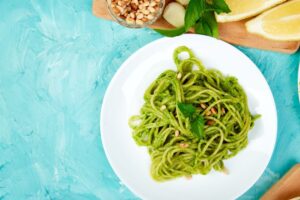Edamame Pasta: Exploring the Health Benefits and Culinary Uses
Edamame pasta transcends the ordinary culinary experience by offering a unique combination of taste and nutrition. Born from the green soybean, this innovative pasta alternative provides a high-protein, high-fiber option for those seeking a healthier twist on traditional noodle dishes. Its quick cooking time, often just a few minutes, makes it a convenient choice for busy lifestyles. Besides the ease of preparation, its nutritional profile boasts a wealth of essential nutrients that are vital for digestive health.

The versatility of edamame pasta is apparent in the myriad of creative recipes it can inspire. Whether tossed in a light sauce or mixed with an array of colorful vegetables, the pasta’s slightly nutty and pleasingly robust flavor serves as a unique base for a multitude of dishes. Notably, it is a gluten-free option, which expands its appeal to those with dietary restrictions. By incorporating edamame pasta into meals, I am able to enjoy a dish that is not only quick and easy to prepare but also supports my commitment to a healthy and balanced diet.
Key Takeaways
- Edamame pasta is a nutritious and quick-to-prepare alternative to traditional noodles.
- It offers a high concentration of protein, fiber, and essential nutrients beneficial for digestive health.
- As a gluten-free option, it’s versatile for creating a variety of healthy and creative dishes.
Unveiling Edamame Pasta
As a versatile and nutritious option, edamame pasta has emerged as a popular alternative to traditional wheat noodles. Known for its rich content in protein, edamame noodles offer a substantial nutrient boost for those seeking a plant-based source. Each serving contains a significant amount of fiber, which supports digestive health and helps in maintaining satiety.
The composition of edamame pasta speaks to its nourishing benefits. It boasts a variety of minerals such as iron, calcium, and magnesium, and is also an excellent source of important vitamins, including vitamin K and folate. These components are pivotal in supporting overall health and wellness.
- Edamame: A young soybean, celebrated for its antioxidants and phytonutrients.
- Protein: Essential for muscle repair and growth, protein is abundantly found in edamame pasta.
- Fiber: Promotes a healthy digestive system and aids in controlling blood sugar levels.
- Minerals & Vitamins: Key elements that are crucial for body functions and preventing deficiencies.
Edamame pasta’s nutritional profile is enhanced by its nutrient density, which outstrips that of many other pasta varieties. Due to its source, the edamame beans, it naturally provides antioxidants that protect the body from oxidative stress.
In the landscape of healthful eating, I find that edamame pasta is not just a fleeting trend but a testament to the evolving dialogue around wholesome foods which is also echoed in discussions on Everything edamame: Biology, production, nutrition, sensory, and economics.
Embracing edamame pasta could be a simple yet impactful choice for those looking to enhance their diet with foods that are not only health-supporting but also enjoyable and easy to prepare.
Cooking Perfect Edamame Pasta
I find that the secret to cooking the perfect edamame pasta is selecting the right product, mastering the cooking techniques, and nailing the desired texture. Let’s explore each of these elements.
Selecting Your Edamame Pasta
When I choose my edamame pasta, I pay close attention to the ingredient list and the nutritional value. My preference is for pasta that contains only edamame or with few additional ingredients, ensuring I get a high-protein and gluten-free meal.
Cooking Techniques
Properly cooking edamame pasta starts with boiling the right amount of water. I use a large pot, bringing the water to a rolling boil before adding a generous pinch of salt for flavor. The amount of salt I use can vary, but about one teaspoon per liter of water is my usual go-to.
Achieving Ideal Texture
For the perfect al dente texture, timing is crucial. Edamame pasta typically cooks in 3-5 minutes. I make sure to start tasting the pasta at the three-minute mark and I’ll know it’s done when it has a slight bite to it, but isn’t hard in the center. Once ready, I promptly drain it while reserving a bit of the cooking water to adjust the sauce consistency as needed.
Creative Recipes with Edamame Pasta
Edamame pasta offers a nutritious alternative to traditional pasta, with a high protein content and a unique, savory flavor. These recipes infuse creativity into every dish, whether you’re craving a refreshing salad or a hearty, flavor-packed meal.
Classic Edamame Pasta Salad
I love giving a healthy twist to traditional dishes, and my Classic Edamame Pasta Salad is no exception. Here’s how I make mine stand out:
- Cook the edamame pasta al dente, then rinse under cold water.
- Toss with chopped tomatoes, sliced cucumbers, and red onion for crunch.
- Dress with a simple vinaigrette made from olive oil, lemon juice, garlic, and Italian herbs.
This salad serves as a perfect side dish or a light lunch that’s both vegan and vegetarian-friendly.
Spicy Edamame Peanut Noodles
For those who enjoy a bit of heat, my Spicy Edamame Peanut Noodles are sure to satisfy:
- I start with edamame pasta, tossing it in a spicy pasta sauce with a peanutty twist.
- The sauce includes a blend of peanut butter, soy sauce, maple syrup, and a dash of red pepper flakes for heat.
- Topped with chopped scallions and crushed peanuts, this dish is a crowd-pleaser that comes together in minutes.
It’s a fusion that respects the essence of both ingredients—edamame and peanut—with a zesty kick.
Creamy Vegan Edamame Pesto
When I’m in the mood for comfort food, my Creamy Vegan Edamame Pesto pasta is my go-to recipe:
- Blend cooked edamame beans with basil, garlic, nutritional yeast, and olive oil for a vegan take on the classic pesto.
- Toss with warm edamame pasta to coat every strand in the creamy sauce.
- A squeeze of lemon juice brings a bright note that balances the rich flavors.
This dish is a testament to how versatile and delectable vegan food can be, especially when you get creative with ingredients like edamame pasta.
Nutritional Advantages of Edamame Pasta
Edamame pasta is becoming a popular choice among those following a low-carb diet and individuals with celiac disease seeking a gluten-free alternative. Compared to traditional wheat pasta, it boasts a higher protein content which is beneficial for muscle repair and growth. This attribute aligns with the needs of a vegan diet, providing a plant-based source of protein often lacking in such dietary patterns.
One serving of edamame pasta contains significant amounts of iron, which plays a crucial role in oxygen transport in the body, and calcium, necessary for healthy bones and teeth. These characteristics make it a smart option for nutritional yeast, laden with B-vitamins, is a fitting accompaniment to edamame pasta, enriching its flavor and vitamin profile.
Edamame pasta also offers a substantial amount of fiber, which contributes to digestive health and can help to regulate blood sugar levels, mitigating spikes after meals. Furthermore, foods high in fiber are known for their potential to manage cholesterol levels, delineating edamame pasta as a healthy choice. Including this pasta in meals can benefit individuals conscious about heart health and those managing diabetes.
Rich in antioxidants, edamame pasta helps safeguard the body against oxidative stress. Pairing it with foods high in magnesium, such as certain nuts or seeds, can enhance its nutritional profile, creating a balanced and nutrient-dense meal.
With its low glycemic index, edamame pasta is less likely to cause rapid increases in blood sugar levels compared to its wheat-based counterparts, aligning with studies on pasta products and their impacts on blood sugar (Overview of Glycemic Index Values). This trait is especially valuable for those managing blood sugar concerns or seeking to maintain a stable energy level throughout the day.
In summary, edamame pasta is a versatile, nutrient-rich option for anyone looking to maintain a balanced diet while enjoying the textures and comforts of traditional pasta dishes.
Serving and Pairing Ideas
As someone who appreciates the nutty, savory flavor and nutritional value of edamame pasta, I have discovered that the versatility of this pasta allows it to be paired and served with a variety of accompaniments, dressings, and even wines to enhance the dining experience.
Accompaniments for Edamame Pasta
Edamame pasta, with its high fiber and protein content, pairs nicely with a range of ingredients that can complement its subtle taste. I recommend tossing it with garlic cloves that have been sautéed in olive oil to infuse it with a pungent aroma and a punch of flavor. A squeeze of lemon juice will add a bright zing that balances the flavors. For a nutrient-packed meal, mixing in baby spinach and tomatoes gives the pasta a delectable freshness, while roasted vegetables can offer a caramelized depth.
- Olive Oil: For sautéing garlic and as the base for dressings.
- Garlic Cloves: Sautéed until fragrant for a flavor base.
- Spinach/Tomatoes: Either fresh or lightly cooked for extra nutrition.
- Roasted Vegetables: Such as peppers, zucchinis, or eggplants to add complexity.
Dressings and Sauces
With edamame pasta’s rich texture, I find that the most enjoyable dressings are those that stick well to the noodles without overwhelming their taste. A classic Italian combination of olive oil, lemon juice, black pepper, and kosher salt always takes the pasta to the next level. If I’m aiming for heartier flavors, I incorporate a creamy dressing including pureed avocado or a rich tomato-based marinara sauce that clings well to the edamame pasta’s unique texture.
- Olive oil & Lemon Juice: Mix with herbs for a simple dressing.
- Black Pepper & Kosher Salt: Fine-tuned seasoning adjustments.
Wine Pairings
When it comes to wine, my preference is to select a bottle that complements the earthiness of the pasta without overpowering it. A crisp Pinot Grigio or a Sauvignon Blanc matches well because their acidity goes hand in hand with the green notes of the edamame. For red wine enthusiasts, a light Pinot Noir can accentuate the meal without being too heavy.
- Pinot Grigio: A white with acidic sharpness to cut through freshness.
- Sauvignon Blanc: Another white with crispness to pair with edamame.
- Pinot Noir: A red that’s light enough to accompany the pasta’s flavors.
In my culinary adventures, edamame pasta has proven to be a sublime dinner choice due to its adaptability to different side dishes, sauces, and wines, all of which contribute to a well-rounded and satisfying meal.
Integrating Edamame Pasta into Your Diet
Integrating edamame pasta into my diet has been a transformative experience, particularly as I am health-conscious and enjoy plant-based proteins. As someone who follows a largely vegetarian lifestyle, I’ve found that this pasta, which is also suitable for vegans, is a substantial source of nutrients and dietary fiber.
Lunch and Dinner Ideas:
- Quick Stir-Fry: I often toss cooked edamame pasta with vegetables and a light soy sauce for a nutritious lunch.
- Pasta Salad: For a refreshing meal, I mix it with diced tomatoes, cucumbers, and a vinaigrette dressing.
- Hearty Dinner: To make a satisfying dinner, I love serving it with a homemade tomato sauce for added wholesomeness.
Edamame pasta’s versatility makes it an ideal ingredient for those quick meals when time is of the essence. Its texture and taste complement a variety of sauces and toppings, making it an easy swap for traditional pasta.
Nutrient Profile:
| Nutrients | Edamame Pasta |
|---|---|
| Protein | High |
| Fiber | High |
| Carbohydrates | Lower than wheat pasta |
Given its rich protein and fiber content, incorporating edamame pasta into my diet supports my goal to consume whole-foods. It fits effortlessly into diverse meal plans, offering a fulfilling alternative to carbohydrate-heavy options. Plus, its quick cooking time aligns perfectly with my busy lifestyle, ensuring that I can maintain a nutrient-dense diet without compromising on taste or convenience.
Frequently Asked Questions
I’ve compiled some common inquiries about edamame pasta to help you understand its benefits, preparation, dietary considerations, contents, availability, and flavor profile.
What are the nutritional benefits of edamame pasta?
Edamame pasta is a nutrient-dense option, as it’s an excellent source of plant-based protein and fiber. These elements contribute to its potential to promote satiety and support overall health.
How do you prepare a simple edamame pasta dish?
To prepare a simple dish, cook the edamame pasta in boiling water until al dente, which typically takes less time than wheat pasta. Then toss it with your choice of sauce or ingredients, like in this edamame pesto pasta recipe.
Can edamame pasta be a good alternative for a low-carb diet?
Yes, while not carb-free, edamame pasta can be a suitable alternative for a low-carb diet due to its higher protein and fiber content compared to traditional pasta.
What are the primary ingredients in edamame pasta?
The primary ingredient in edamame pasta is edamame flour, which is made from ground edamame beans. Some brands might have additional ingredients, but many offer a one-ingredient product.
Where can one purchase edamame pasta?
Edamame pasta can be found in the health food sections of many grocery stores, specialty health food stores, or online. Availability may vary by region.
How does the taste of edamame pasta compare to traditional pasta?
Edamame pasta has a distinct taste, often described as nuttier and slightly more savory than traditional wheat pasta. Many people find it to be a delicious alternative.


 Previous Post
Previous Post Next Post
Next Post